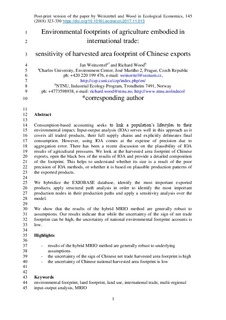| dc.contributor.author | Weinzettel, Jan | |
| dc.contributor.author | Wood, Richard | |
| dc.date.accessioned | 2019-05-22T09:34:53Z | |
| dc.date.available | 2019-05-22T09:34:53Z | |
| dc.date.created | 2018-12-16T20:01:16Z | |
| dc.date.issued | 2018 | |
| dc.identifier.citation | Ecological Economics. 2018, 145 323-330. | nb_NO |
| dc.identifier.issn | 0921-8009 | |
| dc.identifier.uri | http://hdl.handle.net/11250/2598425 | |
| dc.description.abstract | Consumption-based accounting seeks to link a population's lifestyles to their environmental impact. Input-output analysis (IOA) serves well in this approach as it covers all traded products, their full supply chains and explicitly delineates final consumption. However, using IOA comes at the expense of precision due to aggregation error. There has been a recent discussion on the plausibility of IOA results of agricultural pressures. We look at the harvested area footprint of Chinese exports, open the black box of the results of IOA and provide a detailed composition of the footprint. This helps to understand whether its size is a result of the poor precision of IOA methods, or whether it is based on plausible production patterns of the exported products.We hybridize the EXIOBASE database, identify the most important exported products, apply structural path analysis in order to identify the most important production nodes in their production paths and apply a sensitivity analysis over the model.We show that the results of the hybrid MRIO method are generally robust to assumptions. Our results indicate that while the uncertainty of the sign of net trade footprint can be high, the uncertainty of national environmental footprint accounts is low. | nb_NO |
| dc.language.iso | eng | nb_NO |
| dc.publisher | Elsevier | nb_NO |
| dc.rights | Attribution-NonCommercial-NoDerivatives 4.0 Internasjonal | * |
| dc.rights.uri | http://creativecommons.org/licenses/by-nc-nd/4.0/deed.no | * |
| dc.title | Environmental Footprints of Agriculture Embodied in International Trade: Sensitivity of Harvested Area Footprint of Chinese Exports | nb_NO |
| dc.type | Journal article | nb_NO |
| dc.type | Peer reviewed | nb_NO |
| dc.description.version | acceptedVersion | nb_NO |
| dc.source.pagenumber | 323-330 | nb_NO |
| dc.source.volume | 145 | nb_NO |
| dc.source.journal | Ecological Economics | nb_NO |
| dc.identifier.doi | 10.1016/j.ecolecon.2017.11.013 | |
| dc.identifier.cristin | 1643765 | |
| dc.description.localcode | © 2017. This is the authors’ accepted and refereed manuscript to the article. Locked until 21.11.2019 due to copyright restrictions. This manuscript version is made available under the CC-BY-NC-ND 4.0 license http://creativecommons.org/licenses/by-nc-nd/4.0/ | nb_NO |
| cristin.unitcode | 194,64,25,0 | |
| cristin.unitname | Institutt for energi- og prosessteknikk | |
| cristin.ispublished | true | |
| cristin.fulltext | preprint | |
| cristin.qualitycode | 1 | |

